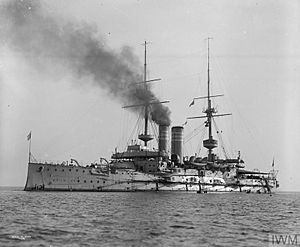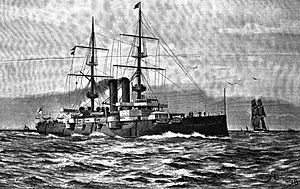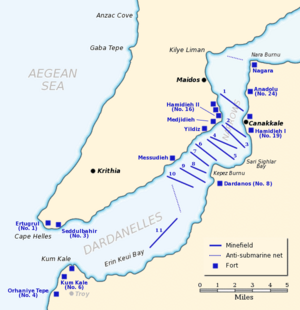HMS Albion (1898) facts for kids
 |
|
Quick facts for kids History |
|
|---|---|
| Name | HMS Albion |
| Ordered | 1896 Programme |
| Builder | Thames Ironworks and Shipbuilding Co. Ltd, Leamouth, London |
| Laid down | 3 December 1896 |
| Launched | 21 June 1898 |
| Completed | June 1901 |
| Commissioned | 25 June 1901 |
| Decommissioned | August 1919 |
| Fate | Sold for scrapping 11 December 1919 |
| General characteristics | |
| Class and type | Canopus-class pre-dreadnought battleship |
| Displacement | Full load: 14,300 long tons (14,500 t) |
| Length | 421 ft 6 in (128.5 m) (loa) |
| Beam | 74 ft (22.6 m) |
| Draught | 26 ft (7.9 m) |
| Installed power |
|
| Propulsion |
|
| Speed | 18 knots (33 km/h) |
| Complement | 750 |
| Armament |
|
| Armour |
|
HMS Albion was a powerful warship called a pre-dreadnought battleship in the British Royal Navy. She was part of the Canopus-class of battleships. These ships were made for serving in Asia. Albion and her sister ships were smaller and faster than earlier battleships. But they still had four large 12-inch (305 mm) guns.
Albion also had thinner armour. However, it was made of new Krupp steel. This new steel was stronger than the older Harvey armour. Albion was started in December 1896. She was launched in June 1898 and joined the fleet in June 1901.
For her first few years, from 1901 to 1905, Albion was stationed far from home on the China Station. After that, she returned to British waters. She served with the Channel Fleet and later the Atlantic Fleet. When First World War began in August 1914, she was called into action. She rejoined the Channel Fleet. Soon after, she was sent to the Atlantic. Her job was to help protect against German warships. In December 1914 and January 1915, she supported operations in German Southwest Africa.
In January 1915, the ship moved to the Mediterranean Sea. She took part in the Dardanelles Campaign. She helped attack Ottoman forts in March 1915. But the British and French navies could not get through the straits. Albion was hit by Ottoman artillery twice during these battles. In October 1915, she went to Salonika. Here, she supported Allied actions against Bulgaria. She did not see more fighting after that. In April 1916, she was sent back to Ireland. She served as a guard ship until October 1918. Then she became a barracks ship. Albion was sold for scrap in December 1919. She was taken apart the next year.
Contents
Ship Design and Features
Albion and her five sister ships were built for duty in East Asia. At that time, Japan was building a strong navy. However, this role became less important after the Anglo-Japanese Alliance in 1902. These ships were made to be smaller, lighter, and faster than earlier battleships.
Albion was 421 feet 6 inches (128.47 m) long overall. She had a beam (width) of 74 ft (23 m). Her draft (how deep she sat in the water) was 26 ft 2 in (7.98 m). She weighed about 13,150 long tons (13,360 t) normally. Her crew included 682 officers and sailors.
Engines and Speed
The Canopus-class ships had two 3-cylinder triple-expansion engines. These engines used steam from twenty Belleville boilers. They were the first British battleships to use water-tube boilers. These boilers made more power and weighed less than older types. The new boilers also changed how the funnels were placed. They were now one behind the other, not side-by-side.
The Canopus-class ships were known for being good and fast steamers. They could reach 18 knots (33 km/h; 21 mph) (about 33 km/h). This was two knots faster than the older Majestic-class ships.
Weapons and Protection
Albion had a main battery of four 12-inch (305 mm) guns. These were placed in two gun turrets, one at the front and one at the back. These turrets could turn all the way around.
She also had a secondary battery of twelve 6-inch (152 mm) guns. These were placed in casemates (armoured rooms). For defense against smaller torpedo boats, she carried ten 12-pounder guns and six 3-pounder guns. Like other battleships of her time, she also had four 18-inch (457 mm) torpedo tubes. These were hidden underwater in the ship's hull.
To save weight, Albion had less armour than the Majestic-class ships. Her belt was 6 inches (152 mm) thick. However, she used Krupp armour, which was stronger than the Harvey armour used before. This meant the protection was still very good. Other parts of the ship also had thinner armour. The bulkheads (walls) at the ends of the belt were 6 to 10 in (152 to 254 mm) thick. The main gun turrets were 10 inches thick. The barbettes (armoured rings supporting the turrets) were 12 in (305 mm) thick. The casemates had 6 inches of Krupp steel. Her conning tower (control room) had 12-inch thick sides. She also had two armoured decks, 1 and 2 in (25 and 51 mm) thick.
Service History
HMS Albion was built by Thames Iron Works in Leamouth, London. Her construction started on December 3, 1896. Her launch on June 21, 1898, was a sad event. After Mary of Teck, the Duchess of York, named the ship, a large wave from Albion entering the water caused a viewing platform to collapse. About 200 people were on the platform. 34 people, mostly women and children, drowned. This was one of the worst accidents in the Thames River during peacetime. Films of the launch and the accident were made. Showing these films caused early debates about videojournalism.
Albion's completion was delayed because her machinery arrived late. She finally started trials in late 1900. More delays happened due to problems with her engines and guns. She was not fully ready until June 1901. HMS Albion officially joined the navy on June 25, 1901. She was based at Chatham Dockyard. Her mission was to replace the battleship Barfleur on the China Station.
She arrived in Hong Kong on September 11, 1901. There, she became the second flagship (a ship carrying an admiral's flag) of the China Station. She had refits (repairs and upgrades) in Hong Kong in 1902 and 1905. In 1905, the United Kingdom and Japan signed an alliance. This meant Britain did not need as many warships on the China Station. So, the Royal Navy called all its battleships back home.
Albion met her sister ships Ocean and Vengeance and the battleship Centurion in Singapore. On June 20, 1905, the four battleships sailed together to Plymouth. They arrived on August 2, 1905. Albion then joined the Channel Fleet. She had a small accident on September 26, 1905. She bumped into the battleship Duncan at Lerwick. But Albion was not damaged.
On April 3, 1906, Albion moved to the Reserve fleet. She had her engines and boilers repaired at Chatham. On February 25, 1907, Albion was taken out of service at Portsmouth.
The very next day, February 26, 1907, Albion was put back into service. She temporarily joined the Portsmouth Division of the Home Fleet. On March 26, 1907, she fully rejoined the fleet. She began serving in the Atlantic Fleet. During this time, she had refits in Gibraltar in 1908 and Malta in 1909. She visited London with the fleet in July 1909. She was also present at a fleet review by King Edward VII and Queen Alexandra at Cowes on July 31, 1909. Albion finished her Atlantic Fleet service on August 25, 1909. She then became a parent ship for the 4th Division, Home Fleet, at the Nore. In May 1912, she became part of the 3rd Fleet at the Nore. She had another refit at Chatham that year. In 1913, she was stationed at Pembroke Dock.
World War I Service
When World War I started in August 1914, Albion was assigned to the 8th Battle Squadron, Channel Fleet. On August 15, 1914, she became the second flagship of the new 7th Battle Squadron. On August 21, 1914, she was sent to the Saint Vincent-Finisterre Station. Her job was to support cruiser squadrons in the Atlantic. This was in case German warships tried to break out into the open ocean. She served as the flagship for Rear Admiral H. L. Tottenham.
On September 3, 1914, she changed her role. She became a regular ship and moved to the Cape Verde-Canary Islands station. She was there to replace her sister ship Canopus. In October 1914, Albion was sent to the Cape of Good Hope Station in South Africa. She became a guard ship at Walvis Bay until November 1914. After the Battle of Coronel on November 1, where a British cruiser group was defeated by German ships, Albion was called back to Table Bay. This was to gather British ships and prevent further defeats. In December 1914 and January 1915, she helped in Allied operations against German Southwest Africa. Later in January, Albion returned to Simon's Town, South Africa. Then she sailed to the Mediterranean Sea.
Dardanelles Campaign
Albion moved to the Mediterranean in January 1915. She joined the Dardanelles campaign. She took part in bombing the Ottoman Turkish forts. These forts guarded the entrance to the Dardanelles on February 19, 1915. This was the first step to force a way through the Dardanelles. Albion was with other British and French battleships. Heavy Ottoman resistance stopped the attack early. So, Albion did not get into action that day. However, she did clear an area for naval mines with the cruiser Amethyst.
Albion joined another attack on the forts on February 25. She was to protect minesweepers. These ships cleared mines after the main bombardment. During this, Albion was fired upon by an Ottoman gun. Other British ships fired back, making the Ottomans stop. Later, the minesweepers began clearing mines. Albion, Triumph, and Vengeance protected them. The next day, Albion, Triumph, and Majestic were to enter the Dardanelles. They were to destroy forts at close range. Albion fired at the fort at Dardanus. The Ottoman response was weak. But then mobile field guns fired at Albion and Majestic. Both ships had to move quickly to avoid serious damage. After Majestic was hit below the waterline, the attack was called off.
On February 28, Albion tried again to attack the Ottoman defenses. She and Triumph led the operation. They were to destroy the repaired fort at Dardanus. Majestic and Ocean supported them by fighting the mobile field guns. As Albion and Triumph got close to Dardanus, they faced heavy fire. This came from Ottoman guns on the European side, including the fort at Erenköy. They had to circle to avoid hits. They fired at Erenköy, which seemed to work at first. Ocean and Majestic tried to attack Dardanus. But they also came under heavy fire from Erenköy. The attack was called off again. The British and French realized they needed to land troops to clear these mobile guns.
Albion supported another operation on March 3. She, Triumph, and Prince George covered a landing party. This party was to raid Sedd el Bahr. Bad weather delayed the start. But the landing happened without problems. Albion shelled Erenköy, which did not fire back. The landing party found and destroyed six field guns. Two days later, Albion tested firing at forts from far away. This was to see if the powerful dreadnought Queen Elizabeth could do it. Albion was to shell a fort protecting Çanakkale. Other battleships covered her. When Albion entered the straits, she came under heavy fire. Especially from Dardanus. Three covering battleships helped her silence those guns. This allowed Albion to anchor and start her bombardment. Queen Elizabeth joined in. But mobile howitzers quickly found both ships. The operation was called off.
On March 18, the Allied fleet launched a big attack. Albion joined ten British battleships and one battlecruiser. Four French battleships were also there. The plan was for the battleships to enter the narrow straits. They would silence the forts. Minesweepers would clear paths through Ottoman minefields. At the same time, transport ships would pretend to land troops. This was to keep the Ottoman mobile guns busy. The British ships damaged the forts at first. But Formidable and then Inflexible started taking serious hits. The French battleships also got damaged. The battleship Bouvet hit a mine and exploded. Albion and other battleships tried to silence Ottoman guns. These guns were firing on boats rescuing Bouvet's crew.
Albion supported the main landings at V Beach at Cape Helles on April 25, 1915. Around 4:30 AM, she bombed the high ground above the beach. But by 5:30 AM, heavy smoke and mist made it hard to see. So, she stopped firing. After Allied troops landed, Albion helped their advance on Sedd el Bahr village. But by 7:30 AM, she had to stop firing again. Friendly troops had entered the town. She then fired to support troops landing at W Beach. But heavy Ottoman fire pushed them back. The report of Allied troops in Sedd el Bahr was wrong. More attacks were launched the next day, which Albion supported. After Albion destroyed a machine gun position, troops could advance into the town. This forced the Ottomans to retreat.
On April 28, 1915, she joined an attack on Krithia. Five French battleships led it, with four other British battleships supporting. Albion was badly damaged by Ottoman shore batteries. She had to go to Mudros for repairs, leaking a lot. Repairs took three days. Back in action on May 2, 1915, she was hit again by Ottoman shells. This meant more repairs at Mudros. On the night of May 22–23, 1915, Albion got stuck on a sandbank near Gaba Tepe. She came under heavy fire from Ottoman shore batteries. About 200 shells hit her. But they could not get through her armour. She had fewer than a dozen casualties. Efforts were made to free her. They reduced her weight and fired her main guns at the same time. Her sister ship Canopus then towed her to safety on May 24, 1915. Albion kept firing at the Ottoman forts while being towed. Albion left the area for repairs on May 26, 1915. She had a refit at Malta in May–June 1915.
Final Operations
In late September 1915, Bulgaria joined the Central Powers in the war. Britain and France talked with Greece. They wanted to send troops to Salonika to attack Bulgaria. On October 4, 1915, Albion arrived at Salonika. She became part of the 3rd Detached Squadron. Her job was to help the French Navy blockade the coasts of Greece and Bulgaria. She also reinforced the Suez Canal Patrol. She carried the first British Army group of 1,500 troops to Salonika. She also escorted French troopships carrying more French soldiers.
Albion served at the Salonika Station until April 1916. Then she became a guard ship at Queenstown, Ireland, later that month. In May 1916, she moved to Devonport for a refit. After that, she went to the Humber in August 1916 to be a guard ship there. In October 1918, Albion's time as a guard ship ended. She was then used as an accommodation ship (a floating barracks). In August 1919, Albion was put on the list to be sold at Devonport. She was sold for scrapping on December 11, 1919. She left Devonport under her own power on January 3, 1920. She arrived at Morecambe for scrapping on January 6, 1920.
|





